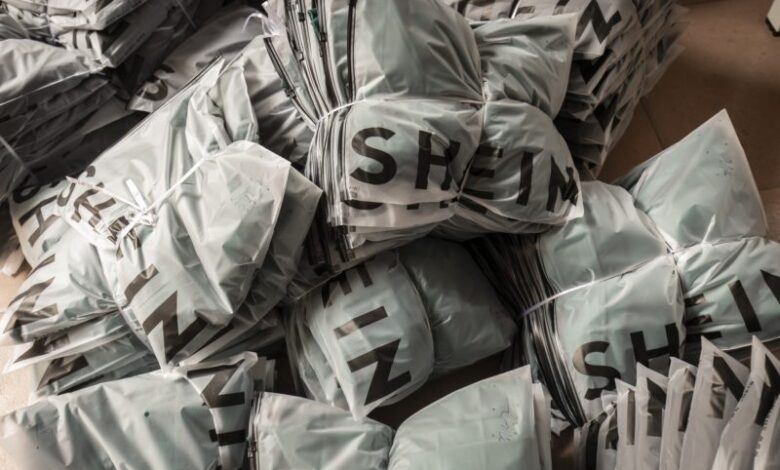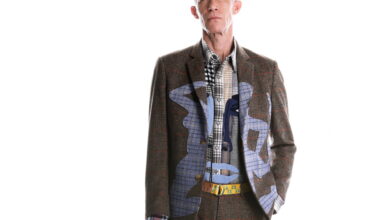The Shein Influencer Trip Controversy, Explained

What experts are calling a classic case of greenwashing can actually double as a lesson in public awareness.
One thing you probably didn’t have on your 2023 bingo card? Fast fashion giant Shein rebranding as a sustainable, ethically-minded company. After a viral influencer trip attempting to do just that, the online retailer — known for its staggering product output and shockingly low prices — has drawn even more attention to its murky behind-the-scenes practices.
RELATED: Shein Responds After Undercover Report Alleges Labour Law Violations
This past week, the Chinese company took a crop of content creators to Guangzhou, China to tour some of its warehouses. One video posted to the brand’s TikTok follows influencers as they visit the “Shein Warehouse” where garments are shipped out to buyers. It shows a guided tour through a brightly-lit factory full of pristine self-sufficient machines seamlessly transporting packages. Inspirational music plays in the background while smiling influencers discuss how impressed they are with the high-tech facility.
“I think my biggest takeaway from this trip is to be an independent thinker, get the facts and see it with your own two eyes,” said one of the visiting influencers, Dani Carbonari (who goes by Dani DMC), in a now-deleted video. The content creator, who has nearly 300,000 followers on TikTok, rejected reports of labour violations and waste, describing the company as “developed and complex.” She went on: “There’s a narrative fed to us in the U.S., and I’m one that always likes to be open-minded and seek the truth.”
And, at face value, she’s not wrong — it does look like a perfectly productive, almost utopian business operation. But it’s just one of the 6,000 reported factories Shein uses in China. To Sarah Jay, a sustainability advocate and founder of consulting firm All Earthlings, this is a prime example of greenwashing. She notes all the processes the tour left out, like milling, dying, cutting and sewing. “Shein also skipped the fracking of crude oil, the melting and extrusion of PET pellets [a form of polyester] into thread, the spraying of cotton fields, and numerous other toxic and gruelling fast fashion processes that have been relegated to workers in the Global South, most of whom are women,” Jay says. “Influencers were shown the tip of the fast fashion iceberg — only the very end of the supply chain — the part just before finished garments arrive at their doorsteps.”
Influencers are a key part of Shein’s business model, with nearly 11 billion views on the TikTok hashtag #SheinHaul, and two billion on videos of creators anointing themselves as proud #SheinPartners. With thousands of new items added to the site per day, the company — valued at approximately $64 billion — has reinvented the fast fashion formula by being quicker, cheaper and essentially limitless. From dresses and handbags to niche dog costumes and chicken nugget necklaces (yes, really) Shein makes practically anything you can think of.
This model is inherently unsustainable, says Taylor Brydges, a course instructor at the Centre for Urban Environments (CUE) at the University of Toronto Mississauga who has a decade of experience studying sustainable fashion. “Shein is putting so many garments on the market that are designed to be trendy for a fleeting moment,” she says, noting that they’re cheaply developed and often meant to be worn once. Within this production formula — which Brydges calls “ultra-fast fashion” — the retailer has come under fire for copying smaller designers, having toxic chemicals in its clothing, and lacking transparency on supply chain details.
A 2021 Public Eye report found that Shein workers in Guangzhou were paid low wages for 75-hour work weeks, with only one day off a month and no paid overtime. In 2022, U.K. broadcaster Channel 4 released Inside the Shein Machine, a documentary that sent undercover cameras to Shein factories in China. It reportedly found that workers were making 500 pieces in 24 hours and clocking up to 18-hour days. While producing high volumes to meet shipping deadlines, they were reportedly paid less than four cents per item, and if mistakes were made on a garment, workers could be docked about $14, which is two-thirds of an entire day’s pay. Most recently, on June 12, Global News released an investigation accusing Shein of producing clothes using forced labour.
In another since-deleted video, Carbonari shared some of the talking points Shein gave her, including that they are “constantly auditing” their manufacturers to make sure they’re complying with labour laws and codes of conduct. But Brydges points to Shein’s self-published sustainability report, which tells a different story. In a 2021 audit, only 2 per cent of factories and warehouses met its workplace standards, with the other 98 per cent falling short. “Their own reporting is showing that their factories and the subcontractors that they’re working with are not aligning with their own codes of conduct,” says Brydges.
Carbonari has addressed the mounting controversy, saying she should have done more research before promoting the brand. Moral of the story? Even though influencers have immense reach and, well, influence, Brydges notes it’s important to keep in mind they are not investigative journalists. And while the controversy surrounding Shein is not new information, in 2023, it’s perhaps more important than ever to keep talking about. The effects of climate change are pervasive. Garment workers are bearing the brunt of fast fashion. Not to mention, Shein just opened a warehouse in Markham, Ontario — further solidifying its presence in the Canadian market.
In light of the above, Sarah Jay feels encouraged by the controversy surrounding the Shein influencer trip. As consumers, our reactions have power when it comes to holding brands and governments accountable for greenwashing and overproduction, she explains. Her advice? “We must keep our wits about us and scratch our fashion itches with reuse, repair, and rental as often as possible.” Of course, for the average shopper, fast fashion is kinda unavoidable. But when you’re buying a top for $5, it’s admittedly easy to forget where it came from and all the work that went into making it. That’s why, in this era of shopping, awareness is invaluable.






